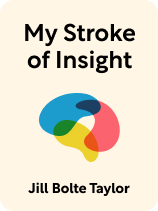

This article is an excerpt from the Shortform book guide to "My Stroke of Insight" by Jill Bolte Taylor. Shortform has the world's best summaries and analyses of books you should be reading.
Like this article? Sign up for a free trial here.
What happens during a stroke? What’s the most common type of stroke? What are the risk factors and symptoms?
After she recovered from a rare type of stroke, neuroscientist Jill Bolte Taylor wrote about the experience in My Stroke of Insight. She explains what a stroke is and discusses ischemic strokes and two types of hemorrhagic strokes. She also talks about the various symptoms that you can experience.
Continue reading to learn about different types of strokes and symptoms that might arise.
Types of Strokes and Symptoms
Given the importance of each section of the brain, any trauma suffered by one part will have a devastating effect on the whole. A stroke is a particular kind of brain injury that results from a malfunction of the circulatory system providing the brain with oxygen and blood. Taylor describes three types of strokes and symptoms that might indicate that you’re experiencing one.
3 Types of Strokes
Taylor talks about three types of strokes and how commonly they occur:
- The most common strokes are ischemic, in which a blood clot blocks the brain’s circulation, causing cells to starve from lack of oxygen.
- A smaller fraction of strokes are hemorrhagic, in which a blood vessel bursts, as with an aneurysm, flooding the brain and drowning its cells.
- A very rare form of hemorrhagic stroke results from a congenital defect in the brain’s blood vessels called an arteriovenous malformation (AVM). Though AVMs account for less than half a percent of all strokes, they are the most common reason for strokes among young people, and it was precisely this type that Taylor experienced at the age of 37.
(Shortform note: AVMs like Taylor’s occur in fewer than 1% of people, and of those cases, under 4% experience bleeding that can lead to stroke. More common risk factors that everyone should be wary of include obesity, high blood pressure, heart disease, and a history of stroke in other family members. Research has also shown a link between severe Covid-19 and stroke. Because one of the symptoms of Covid-19 is increased clotting of the blood, this can elevate stroke risk factors even in people below the age of 50. Whichever type of stroke a person has, the risk of a second stroke remains high: one in four over the next five years.)
Symptoms of a Stroke
Taylor says that strokes are four times more likely to occur in the left hemisphere, which is why they so often impair a person’s ability to speak. A stroke in the left brain also inhibits a person’s ability to define their body’s boundaries or to perceive the passage of time. Damage to the right brain, on the other hand, impairs a person’s ability to interpret meaning, nonverbal cues, or spatial orientation. Because every brain is wired differently, the effects of strokes vary from person to person. Nevertheless, there are warning signs that may give you time to call for help, including the sudden onset of speech difficulties, problems with vision and balance, memory issues, numbness, tingling, or a sharp, severe headache.
(Shortform note: Current research shows that ischemic strokes are only 10% more likely to occur in the left hemisphere, though left-side strokes are also more damaging. The higher frequency and impact may be due to anatomical differences between the hemispheres’ arteries, though it’s also possible that the symptoms of left-side strokes (such as loss of language) are more easily recognized, whereas the symptoms of right-side strokes (such as disorientation) are not as readily apparent.)
If you believe you’re having a stroke, call emergency services or seek help from someone nearby.(Shortform note: It’s possible to feel some symptoms of stroke that fade after minutes or hours. Don’t ignore them. You may have had a transient ischemic attack in which blood flow to your brain was temporarily blocked. If you suspect you’ve experienced one of these attacks, seek medical help immediately. Transient ischemic attacks are a warning that you’re at high risk for a full, debilitating stroke.)

———End of Preview———
Like what you just read? Read the rest of the world's best book summary and analysis of Jill Bolte Taylor's "My Stroke of Insight" at Shortform.
Here's what you'll find in our full My Stroke of Insight summary:
- A neuroscientist's experience and observations after suffering from a stroke
- How the author's stroke helped her develop empathy and stillness
- How best to support stroke survivors






